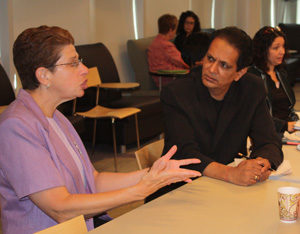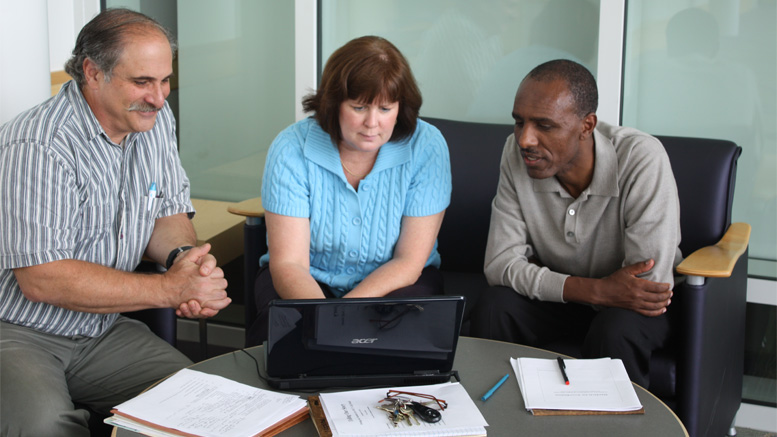In the past, accreditation was focused on “what and how,” says Liang Chee Wee, president of Northeast Iowa Community College (NICC).
“Now it’s more about why, about the impact we have, and the difference we can make,” he says.
College leaders can learn from other institutions through the give-and-take process that happens when an evaluation team visits, Wee says. For example, getting an objective perspective has helped NICC consider “how we can demonstrate our success through more intentional and more comprehensive measurable outcomes,” he says. Wee is one of several college leaders who believe the accreditation process, while time-consuming, can offer important insights.
For Linda Allen, president of Hawkeye Community College in Iowa, the primary value of accreditation is the “verification of the quality of the institution and the quality of education provided to students. It shows they’re getting what they paid for.”
Stamp of approval
Colleges in states served by the Higher Learning Commission can choose among three accreditation options; Hawkeye has selected a continuous quality improvement model known as the “AQIP Pathway.” Allen also finds a new electronic assurance process that allows accrediting bodies to review colleges’ financial data on an ongoing basis to be especially helpful.
“Having the ability to look at the financial stability of institutions is especially important with all the turmoil about for-profits that folded because they were not financially stable,” she says.
The Higher Learning Commission is putting in “bright line indicators,” spelling out what they want from colleges in terms of “you need to be at this point and you need to meet this mark,” Allen says.
That’s not only important for the institution, Allen says.
“It’s important for the public to have very specific indicators of quality and success,” she says. “Parents want to have some verification that the education their son or daughter receives is going to lead to career success.”
Allen believes accreditors need to pay attention to the type of institution under review.
“Community colleges take all comers. We have to look at accreditors using the right measures for community colleges,” she says, noting that the American Association of Community Colleges’ (AACC) Voluntary Framework of Accountability “uses measures that really get at the heart of whether we are successful or not.”
“Most of us like having some third-party verification when we purchase something. Accreditation adds value in the same way,” says Ronnie Booth, president of Tri-County Technical College (TCTC) in South Carolina.
Being evaluated by one’s peers is difficult, but that approach “really does add strength to the accreditation process,” he says. “They’re working professionals who get it. They understand what it takes to make a college work.”
Strategic planning
TCTC, along with every institution accredited by the Southern Association of Colleges and Schools Commission on Colleges, has to complete a quality enhancement plan (QEP), which is more about continuous improvement than checking off a list of boxes, Booth says.
“This plan forces colleges to look at student learning outcomes in a deeper fashion and focus on how they are progressing – or not progressing,” he says. “These are things we should be doing every day,” but requiring this as part of the accreditation process “gives us a deadline to take action.”
As TCTC is in the midst of implementing its second QEP, it’s focusing on incorporating high-impact teaching practices – such as internships, cooperative learning and apprenticeships, for example – across the institution, Booth says. Students learn more when they’re engaged, so “the faculty is developing ways to connect theory to practice and to connect classroom learning to the real world.”
Students in certain fields, like allied health, have long had these opportunities, but TCTC is implementing them in other courses, such as sociology, graphic design and criminal justice.
“It’s one thing to take a chemistry course, but how does a chemist think? We want students to understand that,” Booth says.
Lessons learned
Being put on warning by the Middle States Commission on Higher Education (MSCHE) in 2010 turned out to be “a huge learning experience for us,” says Susan Deer, provost/executive vice president of Rockland Community College in New York.
At the time, MSCHE was strengthening its accreditation process. It was no longer looking for reports from colleges with “a whole bunch of pages of fluff” and statements about what the college was going to do, Deer says. Instead, the accrediting body wanted to know what colleges had done and back it up with evidence.
It was no longer just about the report; the focus was on creating a culture of assessment, Deer says. “It was all about whether our students are learning what we say they’re learning. And if not, how do we improve that?”
That led to real change at the classroom level, she says. In one example, an English instructor who taught students to “know their audience” when working on writing assignments had much better results than another instructor who didn’t cover that point. As a result, all English faculty now are expected to cover that lesson.
Since then, Rockland has done very well on the Middle States Self Study. In the past, three or four people wrote the report, Deer says. Now it’s done by a larger group from across the campus, and two faculty members chair the steering committee.
Camille Preus, president of Blue Mountain College in Oregon, finds it helpful that the mid-cycle of its accreditation review by the Northwest Commission on Colleges and Universities is aligned with the review of its own strategic plan.
Ensuring the college has a relevant and responsive curriculum and effective assessment is a key part of both efforts, Preus says.
Following an accreditation review done in 2014, Blue Mountain prioritized student learning outcomes and the need for evidence showing that curricula, courses and programs are effective.
“When carried to the logical conclusion,” Preus says, the key question is: “Are students getting hired in their field and are they earning at least a minimum wage?” As a result of that review, one program – for para-educators – was found to have low enrollment, low completion and low employment. As a result, it was eliminated.
Quality professional development
After leading two accreditation evaluation teams, Preus learned much about “how colleges are putting together plans to evaluate student learning and what evidence they are using to measure the results.” She would like to see more opportunities for colleges to share best practices on how they use assessments of student learning to improve curricula.

Faculty and staff at an accreditation workshop at Manchester Community College. (Photo: MCC)
Being on an accreditation team “is the single best professional development opportunity for a president,” says Gena Glickman, president of Manchester Community College (MCC) in Connecticut.
“It’s a wonderful opportunity to learn how other institutions operate,” says Glickman, who has served on evaluation teams for both MSCHE and the New England Association of Schools and Colleges.
It’s a good way to observe objectively how institutions in other states are funded, how they approach problems and solve them, how their governance structure works, and whether they are true to their mission, she says.
Glickman has also served as an evaluator for national accreditation bodies for specific programs, which presents an opportunity to look at curricula, course outcomes and instructional pedagogy.
Many of MCC’s programs – in allied health, early childhood education, culinary arts and other areas – are accredited by national bodies. That helps attract students and also provides for smoother transfer articulation.
“Accreditation gives our community and our multiple constituents a way to make choices about the institutions they choose to attend,” Glickman says. “Accreditation ensures we are accountable and are good stewards of resources.”
John “Ski” Sygielski, president of HACC, Central Pennsylvania’s Community College and a former AACC board chair, says being able to visit other colleges as part of an accreditation evaluation team was “one of my best professional development experiences.”
It’s a great way to learn about best practices to bring back to one’s own institution, says Sygielski, citing ideas from other colleges about partnerships, benefits, financing and developing curricula with businesses.
Knowing what the accreditation team is looking for, he says, “provides an opportunity to learn where we may be weak and strengthen those areas before an evaluation teams comes.”
Improving the process
“Community colleges are reinventing ourselves,” Sygielski says. “The traditional degree may not be the coin of the realm anymore. We need to be much more agile and more responsive to the business community.” And that means “we need to work with accreditation bodies to help us be innovative as higher education evolves, so we can be evaluated in different ways and with different metrics.”
Accreditation bodies also need to keep an eye on the future, Sygielski says, citing such issues as how to gauge distance learning and massive open online courses; what is the right mix of certificates and degrees; how to measure competency-based education; and how to meet the needs of employers, which is very different from the traditional model of higher education.
NICC’s Wee agrees that accreditors need to understand how the higher education environment is quickly changing, especially at community colleges. His college’s curriculum is based on what industry needs. Changing a curriculum can take time “but businesses can’t wait. That can be challenging,” he says.
Wee would like accreditors to focus more on competency-based education rather than seat time. Military veterans with certain skills need to move through a program as quickly as possible, for example, although that doesn’t mean colleges should lower their standards.
The accreditation process gives us a way to “look in the mirror and ask whether we are doing what we’re supposed to be doing,” Wee says. “That process is also like looking into a window into future possibilities, as we ask what we can do better.”

